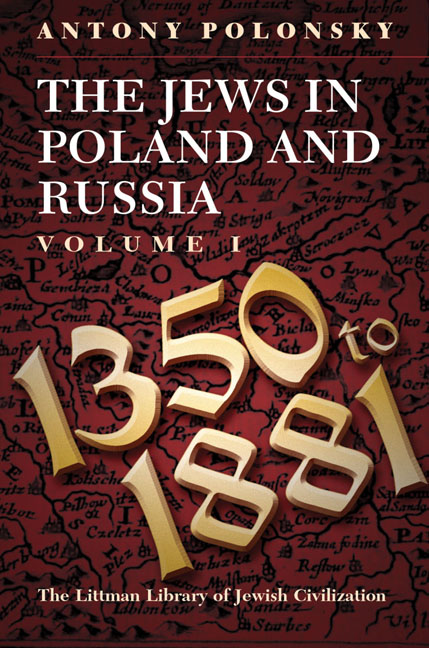Book contents
- Frontmatter
- Dedication
- Acknowledgements
- Contents
- List of Maps
- List of Tables
- Note on Transliteration
- Note on Place Names
- Maps
- General Introduction
- PART I JEWISH LIFE IN POLAND–LITHUANIA TO 1750
- PART II ATTEMPTS TO TRANSFORM AND INTEGRATE THE JEWS, AND THE JEWISH RESPONSE, 1750–1880
- Glossary
- Bibliography
- Index
Introduction
- Frontmatter
- Dedication
- Acknowledgements
- Contents
- List of Maps
- List of Tables
- Note on Transliteration
- Note on Place Names
- Maps
- General Introduction
- PART I JEWISH LIFE IN POLAND–LITHUANIA TO 1750
- PART II ATTEMPTS TO TRANSFORM AND INTEGRATE THE JEWS, AND THE JEWISH RESPONSE, 1750–1880
- Glossary
- Bibliography
- Index
Summary
BY THE MIDDLE of the eighteenth century the Jewish community of Poland– Lithuania had become the largest Jewish community in the world and a centre of Jewish intellectual and religious life. This development was the result of a fundamental transformation of the geography of the Jewish world between 1200 and 1550. From the twelfth century the position of the Jews in the Arab world began to deteriorate, while at about that time in western Europe a series of expulsions occurred, starting with that from England at the end of the twelfth century and culminating in the forced conversion of part and the emigration of the remainder of the largest Jewish community in western Europe, that in Spain. As a result, Jews were now concentrated in three small and two larger communities.
The three smaller communities were to be found in Italy, in the German states including that of the Habsburgs, whose rule extended to some largely non- German territories, such as Bohemia, Moravia, and Hungary, and in the port cities of the Atlantic coast of Europe. Italy at this time was not subject to a single ruler, and Jews were found in the Papal States, in the Republic of Venice, in the Grand Duchy of Tuscany, and in the smaller states of the north. The Jewish community had a mixed character: some of its members were descendants of the earliest Jewish settlers in the peninsula, some had moved there from the German lands from the twelfth century on, and some were immigrants from the Iberian peninsula. Perhaps 40,000 Jews lived in Italy by the end of the eighteenth century.
Germany at this time was also politically divided. On the eve of the French Revolution there were more than 300 states in German-speaking Europe, ranging from great states like the Habsburg empire, Prussia, and Saxony to free cities like Hamburg, Frankfurt am Main, and Lubeck. Jews were found in these free cities as well as in tiny principalities and medium-size and large states. When they were expelled from one area they were able to move to another. In the middle of the eighteenth century there were about 70,000 Jews in central Europe.
Jews were also able to settle in many of the ports which developed with the growth of transatlantic commerce from the sixteenth century.
- Type
- Chapter
- Information
- The Jews in Poland and RussiaVolume I: 1350 to 1881, pp. 7 - 8Publisher: Liverpool University PressPrint publication year: 2009

